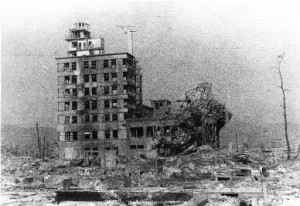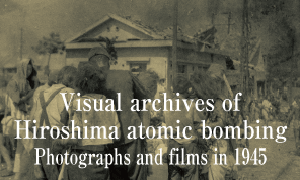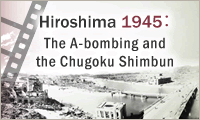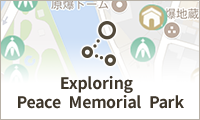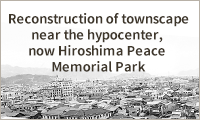Hiroshima: 70 Years After the A-bombing Part 19
Aug. 20, 2015
Coverage of the A-bombing: until the nuclear age is brought to an end
What happened to people as a result of the atomic bombing of Hiroshima by the United States on August 6, 1945? What do they ask of the future now? “A-bomb reporting” examines the bombing not from the vantage point of the nations that possess nuclear weapons but from that of the people who were made to suffer as a result. There was trial and error along the way, and the reporting has inevitably been criticized as formulaic and repetitive. But as long as the “nuclear age” goes on, the news media will have a duty to cover these issues, continuing and expanding their coverage. The 70th anniversary of the atomic bombing is both a milestone and a “relay station” on the path to the future.
News outlets suffered a crippling blow as a result of the atomic bombing. The Chugoku Shimbun building located in Kami Nagarekawa-cho (now Ebisu-cho, Naka Ward) was gutted by fire, and 114 of the newspaper’s employees, one third of the total, were killed, including those who had been mobilized for the demolition of buildings to create firebreaks. Publication of the only newspaper in the prefecture halted.
Satoshi Nakamura, then 36 and an editor for the Hiroshima bureau of the Domei News Agency (now Kyodo News), reported that the city had been completely destroyed by fire and that about 170,000 people had died. According to “Hiroku Dai Toa Senshi” (“Secret Records of the Greater East Asia War”), a history published in 1953, Mr. Nakamura filed his report at 11:20 a.m. on August 6 from the Hara Studio of the Hiroshima Central Broadcasting in Gion-cho (now part of Asa Minami Ward) in the northern part of the city using a dedicated line to the broadcaster’s Okayama studio.
According to essays he published in 1956, Yoshie Shigetomi, then 37 and a reporter for the Hiroshima bureau of the Mainichi Shimbun, escaped from his home in Tate-machi (now part of Naka Ward) and headed for the Kabe Police Station (now the Asa Kita Police Station). He asked the police to file via police telephone the report he had written under the title “Entire City Completely Destroyed.”
The first reports of the total destruction of the city were filed by journalists who were themselves caught up in the unprecedented calamity. But in some cases their news of the enormous scale of the devastation was not believed or was not delivered, becoming “phantom reports.”
The reporters who hurried to the gutted headquarters of the Chugoku Shimbun made their way through a city filled with dead bodies to the Imperial Japanese Army’s Shipping Command in Ujina (now part of Minami Ward). There they used a radio to ask other newspaper companies to print the Chugoku Shimbun, according to a history of the paper published in 1972 to mark the 80th anniversary of the company’s founding. Newspapers, which were essential for conveying information to the public, began reaching Hiroshima with the August 9 edition. The papers, which bore the masthead of the Chugoku Shimbun, were printed at the western headquarters of the Asahi and Mainichi newspapers.
Shocked by notion of a city uninhabitable for 70 years
With the August 15 broadcast of the Imperial Rescript on the Cessation of the Hostilities in which Emperor Hirohito announced that the government had accepted the Potsdam Declaration, governmental and military restrictions on news coverage gave way to a flood of coverage on the devastation caused by the atomic bombing.
Hiroshima residents were shocked by the opinion of an American researcher who stated that the city would be uninhabitable for 70 years. On August 23 the Osaka edition of the Mainichi Shimbun said, “For the next 70 years no vegetation will be able to grow nor will any living thing be able to inhabit the area.”
Two days after the A-bomb was dropped, the U.S. Department of the Army issued a statement denying that there would be any effects from radiation. Brigadier Gen. Thomas Farrell, who entered the city on September 9, said there was “no evidence of continuing radioactivity in the blasted area.”
The Chugoku Shimbun, which had resumed printing its paper at a suburban plant in Nukushina (now part of Higashi Ward), ran an article on September 10 under a headline that referred to the theory that nothing would grow for 75 years as “a lie.” In its edition of September 15 the paper reported that deaths had exceeded 110,000 and that atomic bomb-related diseases were “inevitable.” The paper also touted the benefits of moxibustion. Scientists and doctors were unfamiliar with the effects of an atomic bombing, which continue to this day.
On September 19, the General Headquarters of the Allied Forces (GHQ) imposed a press code on newspapers and other publications, radio broadcasts and films. Anything that incited distrust or resentment of the Occupation forces was repressed. On the other hand, coverage that highlighted recovery from the destruction and peace was deemed to be in line with Occupation policy.
The term “atomic bomb” did not completely disappear from the public realm. The “Hiroshima Rally to Preserve Peace” submitted a 14-line item to the October 3, 1949 edition of the Chugoku Shimbun stating it had resolved that “the manufacture of atomic bombs should be banned,” making it the first published call to ban the bomb.
The Civil Censorship Detachment was abolished at the end of October 1949, but with the outbreak in June 1950 of the Korean War against the backdrop of the conflict between the U.S. and the Soviet Union, GHQ began pointing fingers at people, and those who were believed to be Communist sympathizers were fired from various news outlets. The Hiroshima Peace Festival (now the Peace Memorial Ceremony) was also suspended.
News outlets lifted their self-imposed restrictions on the news media following the end of the Occupation in April 1952 with the entry into force of the Treaty of San Francisco. Photographs documenting the devastation of the atomic bombings were published in Asahi Graph and other publications. There were reports on A-bomb orphans and single women who had keloid scars, but the focus of the coverage was mostly limited to eliciting sympathy.
A major turning point came in March 1954 with the U.S. test of a hydrogen bomb on Bikini Atoll. Fear of the so-called “ashes of death” caused an outcry from the public, which sought a ban on atomic and hydrogen bombs. The first World Conference Against Atomic and Hydrogen Bombs was held in Hiroshima in 1955, and the following year the Japan Confederation of A- and H-Bomb Sufferers Organizations was formed.
In Hiroshima and Nagasaki, people who had been pushed to the margins of society stood up and called for government assistance. News coverage began to support their emotional plea and the spread of their movement.
In the summer of 1962, when the ban-the-bomb movement was in disarray as the result of conflicts between political parties and labor unions, the Chugoku Shimbun published “Testimonies of Hiroshima,” a 33-part series in its local news pages that examined the situations faced by atomic bomb survivors, families of those who had died and doctors. The series was intended to “examine the effects the atomic bombing had had on people’s lives and feelings.”
Preparation of white paper advocated
In an editorial published on August 6, 1964, the Chugoku Shimbun advocated the preparation of a white paper saying, “Now is the time for the horrors of the atomic bomb – rather than its power – to be thoroughly examined and made known to the world.” The Science Council of Japan supported this idea, which led to the implementation of a study of atomic bomb survivors by the Ministry of Health and Welfare.
In the summer of 1965, “20 Years after the Bombing” a 30-part full-page feature consisting of “Convey These Voices to the World,” “Journey from the Fire” and “Record of Hiroshima” was published. This series laid the foundation for reporting that examined the A-bombing from the perspective of those who had been made to suffer as a result of it.
Yoshio Asano, 83, who did reporting for “Convey These Voices to the World,” said he felt conflicted over postcards he received from readers asking him to end the series, which they said was reopening old wounds that they would rather forget. Mr. Asano was a second-year student at Hiroshima Second Middle School (now Kanon High School) at the time of the A-bombing. All of the school’s first-year students, who were working at the site where Mr. Asano had worked the day before, were killed. Mr. Asano began telling his story after he turned 80 in the belief that the A-bomb experience could never be fully told.
After the publication of “Journey from the Fire,” which looked at the 20 years since the atomic bombing, the reporters who had worked on it turned to covering atomic bomb survivors in South Korea, who had suffered colonial rule and then been abandoned by the Japanese government. The coverage cited the need for assistance for these survivors. In the 1970s the press supported the Son Jin Doo case, opening the door for aid to be provided to survivors living overseas.
Takashi Hiraoka, 87, a reporter who later became mayor of Hiroshima, said, “Japan’s unwillingness to acknowledge its mistakes is connected to the U.S. failure to address its responsibility for the dropping of the atomic bomb.” He added, “The A-bomb survivors also represent a rejection of the logic of a state that abandons its people. The dead who were killed have not been saved either. In this day and age, in which we have also witnessed the nuclear disaster at Fukushima, it is the duty of Hiroshima to seriously examine the problem of human beings and their relationship to nuclear weapons and nuclear power from the standpoint of inhumanity.”
In “Hiroshima Sengoshi” (“Hiroshima Postwar History”), a book written last year by Satoru Ubuki, 68, the author observed that coverage of the atomic bombing and its continuity were unique.
Advocacy A-bombing journalism was undertaken from various viewpoints and in various ways including a 1966 NHK program on the effort to rebuild the hypocenter area, the network’s 1974 program soliciting A-bombing artwork and a 1967 interview survey of A-bomb survivors conducted by the Asahi Shimbun.
Mr. Ubuki credited the news media with “digging up facts on the atomic bombing, advocating movements that involved universities, government and the public, and spurring efforts to pass on the A-bombing experience to the next generation.” At the same time he warned that in recent years the news media have “taken up similar easy-to-understand matters and are telling a simplified version of Hiroshima’s story.”
As of the end of March 25, 2015, the average age of the A-bomb survivors was 80.13. The accounts they are able to give and the time they have left are even more limited. While efforts toward peace by government and the public’s endeavors to pass on the A-bombing experience have diversified, they have also become more like “events.”
But a tremendous volume of records and recollections of the atomic bombing have been accumulated including personal effects and writings that carry the sentiments of those who died and their family members, efforts to portray the A-bombing experience, and reports on research conducted in Japan and overseas. Bringing these into the present and considering the future has become even more important. Telling the story of Hiroshima is a task that has been entrusted not only to the news media but to each of us.
This is the final article in this series. The reporters were Masami Nishimoto, senior staff writer, and Kyosuke Mizukawa, Junji Akechi and Michiko Tanaka, staff writers in the news department. Kosuke Takeuchi was in charge of page layout.
The Atomic Bombing of Hiroshima and the News Media
Aug. 6, 1945
U.S. drops atomic bomb on Hiroshima
Aug. 7, 1945
Imperial Japanese Army headquarters announces via radio that the bomb was a “new type”; newspapers throughout Japan carry front-page stories on the announcement in their August 8 editions
Aug. 7, 1945
The International News Service, an American news agency, reports the opinion of a scientist involved in the development of the atomic bomb that the radiation in Hiroshima would not dissipate for about 70 years
Aug. 9, 1945
The Chugoku Shimbun, whose headquarters were gutted by fire, resumes publication with papers printed for it by the western Japan headquarters of the Asahi Shimbun and Mainichi Shimbun
Aug. 10, 1945
The Japanese government protests the atomic bombings, telling the U.S. it “should give up the use of inhumane weapons”
Aug. 11, 1945
The Osaka edition of the Asahi Shimbun uses the term “atomic bomb” in a headline
Aug. 15, 1945
The Imperial Rescript on the Cessation of the Hostilities is broadcast
Aug. 19, 1945
Photos of the ruins of Hiroshima by Satsuo Nakata, a reporter for the Domei News Agency (now Kyodo News) are published in newspapers throughout Japan
Aug. 23, 1945
The Osaka edition of the Mainichi Shimbun carries an article saying that Hiroshima will be “uninhabitable for 70 years”; the report is subsequently carried in the Aug. 27 edition of the Chugoku Shimbun
Aug. 31, 1945
Hawaii native Leslie Nakashima, a former employee of the United Press Tokyo bureau, comes to Hiroshima in search of his mother; his reporting on Hiroshima is carried in the New York Times
Sept. 3, 1945
The Chugoku Shimbun resumes printing its paper at a plant in Nukushina (now part of Higashi Ward); Nippon Eigasha films devastated Hiroshima; Western newspaper and wire service war correspondents arrive in the city
Sept. 4, 1945
The Osaka edition of the Asahi Shimbun publishes an article on the devastation of Hiroshima along with four photos of A-bomb survivors taken by its photographer Hajime Miyatake, who entered the city on August 9
Sept. 11, 1945
The Chugoku Shimbun publishes the three-part series “Anatomy of the Atomic Bomb” featuring discussions with Masao Tsuzuki, a professor at the University of Tokyo, and others
Sept. 19, 1945
GHQ issues its press code
July 6, 1946
Two of the five photos taken by Yoshito Matsushige, a photographer for the Chugoku Shimbun, on the day of the A-bombing are published in “Evening Edition Hiroshima”
Aug. 6, 1947
The first Peace Festival (now the Peace Memorial Ceremony) is broadcast live on the radio locally by JOFK (now the Hiroshima studios of NHK)
Aug. 6, 1948
The Peace Festival is broadcast nationwide
April 28, 1952
The Treaty of San Francisco becomes effective
June 5, 1952
Filming of “Children of Hiroshima” directed by Kaneto Shindo begins on location in Hiroshima
Aug. 1, 1952
Sekai and Fujin Koron magazines publish feature articles on the atomic bombing
Aug. 6, 1952
Asahi Graph publishes 18 photos of Hiroshima and eight of Nagasaki in an article headlined “First look at A-bomb devastation”; 700,000 copies are printed
Sept. 29, 1952
Life magazine publishes 14 photos of the A-bombings of Hiroshima and Nagasaki previously unseen in the U.S.
Nov. 15, 1952
Kaizo magazine publishes a 208-page feature on the atomic bombings
Aug. 1, 1953
Through Aug. 9 NHK broadcasts a special radio program on assistance for survivors suffering from the aftereffects of the A-bombing
March 1, 1954
Hydrogen bomb tested on Bikini Atoll
Aug. 1, 1954
Sunday Mainichi publishes “Tsuioku” (“Recollections”) compiled by the Association of Bereaved Families of Hiroshima First Middle School
Aug. 6, 1955
The first World Conference Against Atomic and Hydrogen Bombs is held in Hiroshima
Aug. 10, 1956
The Japan Confederation of A- and H-Bomb Sufferers Organizations is formed
July 15, 1962
The Chugoku Shimbun publishes its 33-part “Testimonies of Hiroshima” series
Aug. 7, 1964
Asahi Graph publishes a 29-page feature on former residents of the Hiroshima War Orphans Foster Home
Aug. 31, 1964
The Chugoku Shimbun publishes “The Atomic Bomb Survivors of Okinawa,” an 11-part series on survivors living under U.S. military administration
July 8, 1965
The Chugoku Shimbun publishes the full-page 30-part series “20 Years after the Bombing”
July 20, 1965
The Asahi Shimbun publishes “Experiences of the Atomic Bombing” featuring accounts of survivors solicited by the City of Hiroshima in 1950
Nov. 25, 1965
The Chugoku Shimbun publishes the first reporting on atomic bomb survivors residing in South Korea
Aug. 3, 1966
NHK’s program “Within 500 Meters of the Hypocenter” is broadcast in the Chugoku region; the movement to reconstruct the hypocenter area grows
Nov. 23, 1966
Hiroshima Television’s program depicting the lives of A-bomb survivor couples wins the “Encouragement Prize” in the National Arts Festival
Aug. 4, 1967
NHK broadcasts “The Flash beyond Our House: Reborn Hypocenter Neighborhoods” nationwide
April 20, 1968
“Effects of the Atomic Bomb on Hiroshima and Nagasaki,” a film shot by Nippon Eigasha in October 1945 and seized by the U.S. military, is returned to Japan and broadcast by NHK Educational TV and RCC Broadcasting
Oct. 9, 1969
“Ishibumi” (“Monument”), a program on the deaths of first-year students at Hiroshima Second Middle School, is broadcast by Hiroshima Television
Aug. 3, 1970
The 29-minute film “Hiroshima: A Document of the Atomic Bombing” produced by the City of Hiroshima, the Chugoku Shimbun, RCC Broadcasting and Hiroshima Television is completed and broadcast nationwide on August 6
May 5, 1972
The Chugoku Shimbun donates copies of the English edition of “Hiroshima: A Document of the Atomic Bombing” to 14 newspapers in Europe, the U.S. and Asia
June 4, 1973
Publication of “Barefoot Gen,” a manga series by Keiji Nakazawa, in “Shonen Jump” begins
June 8, 1974
An NHK program about a picture of the A-bombing drawn by Iwakichi Kobayashi, 77, is aired on local television
July 11, 1975
An exhibition on the A-bombing of Hiroshima sponsored by Hiroshima Prefecture, the City of Hiroshima, the Chugoku Shimbun and NHK Chugoku Headquarters opens in Sapporo and later travels to four other cities
Aug. 6, 1975
An NHK program soliciting artwork related to the atomic bombings is broadcast nationwide; over the next two years 2,225 pictures are submitted
July 25, 1979
“Hiroshima and Nagasaki,” a 504-page book on the atomic bombings jointly edited by the two cities is published by Iwanami Shoten
Aug. 5, 1984
NHK broadcasts a special program on “The Post-Nuclear War World” on two evenings; its audience share is 24.1 percent
Jan. 1, 1985
The Chugoku Shimbun’s 86-part series “700 People of Danbara” examines the situations of aging A-bomb survivors, their feelings and issues related to their support
July 29, 1985
Time magazine carries a 27-page special section titled “The Atomic Age” featuring reporting on A-bomb survivors
Aug. 6, 1985
The major U.S. television networks, ABC, CBS and NBC, broadcast live coverage of the Peace Memorial Ceremony for the first time by satellite
May 21, 1989
The Chugoku Shimbun 134-part series “Exposure: Victims of Radiation Speak Out” looks at atomic bomb survivors in 15 countries around the world
Jan. 22, 1995
The Chugoku Shimbun publishes its “History of Hiroshima” series on the city’s postwar history in 30 two-page installments; a timeline of 1,946 pages is published in July
July 24, 1995
Newsweek magazine publishes a 24-page feature titled “Why We Did It” on the facts behind the atomic bombing and the gap in perceptions of it between Japan and the U.S.
Oct. 15, 1998
The Chugoku Shimbun’s series “Record of Hiroshima: Photographs of the Dead Speak” is published; the three-year project undercovers information on the deaths of 2,369 people in the vicinity of the hypocenter
Dec. 22, 1999
The Associated Press announces the 100 top news stories of the 20th Century for Asia with the atomic bombings of Hiroshima and Nagasaki first and the Russian Revolution second
Nov. 26, 2000
RCC Broadcasting’s radio drama “The Black Cross of Hiroshima” wins the grand prize in the National Arts Festival
Sept. 30, 2003
Publication of Fumiyo Kono’s manga series “Town of Evening Calm” in Manga Action begins
July 20, 2004
The peace museums and NHK studios in Hiroshima and Nagasaki, the Chugoku Shimbun and the Nagasaki Shimbun solicit materials on the atomic bombings
Jan. 1, 2008
The Chugoku Shimbun establishes the Hiroshima Peace Media Center to disseminate information in multiple languages on its website
(Originally published on August 3, 2015)

